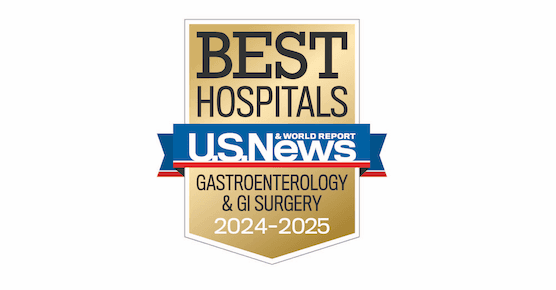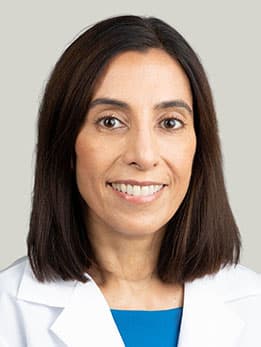Endoscopic Submucosal Dissection (ESD)
Endoscopic submucosal dissection (ESD) is a minimally invasive procedure to examine and remove growths from the lining of the gastrointestinal (GI) tract without surgery. For early-stage cancers of the esophagus, stomach and colon, an ESD may offer a cure.
At the University of Chicago Medicine Center for Endoscopic Research and Therapeutics (CERT), our interventional gastroenterologists are highly skilled in performing ESDs and helping patients — even those with larger cancerous growths — avoid surgery to remove part of their GI tract. An ESD may even help some people avoid having an ostomy.
What is endoscopic submucosal dissection?
An ESD is a minimally invasive procedure in which a specially trained doctor uses an endoscope (small camera on a long, thin tube) to remove growths in the digestive tract. It can also be used to help stage early cancers or rule out cancer in suspicious growths.
An ESD is an evolution of an older technique called endoscopic mucosal resection (EMR), which has been performed for more than 15 years at UChicago Medicine. But unlike the older EMR procedure, an ESD can be used to remove larger growths in the GI tract in one piece. This makes it easier for a pathologist to accurately determine if a growth is cancerous.
Who is a good candidate for an ESD?
An ESD may be an option for you if you have:
- Barrett’s esophagus with early cancer
- Superficial esophageal squamous cell cancer
- Early stomach cancer
- Early colorectal cancer
- Some types of colon polyps (especially large rectal polyps, which have a higher chance of being cancerous)
Typically, the best candidates for an ESD are patients who have or may have early cancers in their esophagus, stomach or colon, or who have certain types of benign (non-cancerous) polyps that cannot be treated during a regular colonoscopy.
What is the difference between endoscopic mucosal resections vs. endoscopic submucosal dissections?
Both EMRs and ESDs are advanced, minimally invasive procedures that use endoscopic tools to remove growths in the digestive tract. The main difference is that doctors use different surgical instruments during the procedures.
During an EMR, a doctor uses a tool called a snare, which is an instrument with a wire loop attached on the end. It can be used to remove small polyps and growths.
During an ESD, a doctor uses a very precise electrosurgical knife that can be used to remove larger, “flatter” growths in the digestive tract and help with cutting through scarred tissue. With this instrument, a doctor can also remove growths that may be deeper in the lining of the GI tract, which can provide more accurate staging if cancer is suspected.
Both procedures require specialized endoscopic expertise, but only a select group of centers have the experience to perform ESDs, which are more difficult to perform than EMRs.
Frequently Asked Questions about Endoscopic Submucosal Dissection (ESD)
During the ESD, you will be given sedation by an anesthesia team. The doctor will insert a long, thin tube called an endoscope through your mouth and down your esophagus or up through your anus if the growth is in your colon. The growth will be identified using special dyes or imaging techniques, and the borders will be marked so that the doctor can easily see it. A liquid will be injected into the tissue beneath the growth to make it easier to remove and lift it away from the deeper muscle layer of the wall. Then, the doctor will use a highly precise cutting knife to remove the growth as well as a small amount of surrounding tissue.
An ESD is performed by a gastroenterologist with expertise in interventional endoscopy. An ESD requires a significant amount of training, technical skill and experience, so it is important to visit a center that routinely performs these procedures.
If you are like most people who have an ESD, you probably won’t have much discomfort after your procedure. You will be able to go home the same day unless your doctor recommends that you stay overnight for observation. You’ll be able to return to your normal activities in a few days.
Traditionally, patients with large growths or tumors in their digestive tract would need to have surgery, which might involve removing part of the esophagus, stomach or colon. However, with an ESD, patients can keep their organ because only the growth and a small amount of surrounding tissue is removed.
For early forms of cancer, an ESD is considered a cure with a very high survival rate after five years. It is possible that you may still need chemotherapy or surgery after an ESD, depending on the extent of your cancer and what the final stage is based on the pathology.
Risks associated with an ESD include bleeding, pain, puncture of the digestive tract and scarring that narrows the esophagus. These risks vary based on where the cancer or growth is in your digestive tract.
At UChicago Medicine, a multidisciplinary team of gastroenterologists, oncologists, surgeons and other experts will review your case and work with you to find the best treatment plan. If you are a candidate for an ESD, our team will refer you to a highly skilled interventional gastroenterologist who has been performing this procedure for many years.
A hybrid treatment combining an EMR and an ESD is also available at UChicago Medicine for treating certain growths in the gastrointestinal tract.
Our team is also involved in international research studies to examine the best tools and techniques for performing ESDs so we can continue to offer the latest advances to our patients.
Meet Our Endoscopic Submucosal Dissection Specialist

Nationally Ranked in Gastroenterology and GI Surgery
According to U.S. News & World Report's 2024-25 Rankings.
Learn more about U.S. News Best Hospitals
